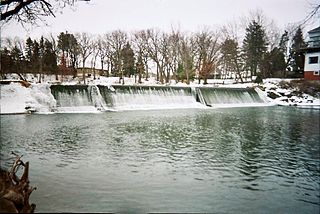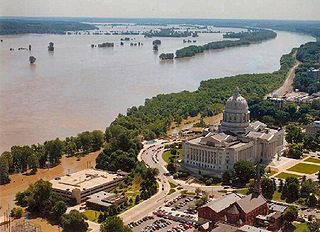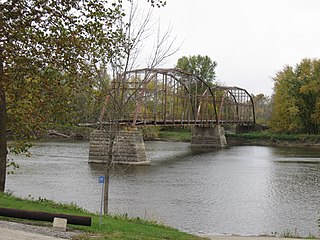Burlington
In the city of Burlington,the river played havoc with national transportation.
In the early morning hours of May 1,2008,five river barges came loose from their moorings at a staging area a short distance upstream of Burlington. While two ran aground before they reached the city,the remaining three struck the far eastern pier of the Great River Bridge with minimal impact. The bridge was closed to traffic until later the same afternoon,after the Iowa Department of Transportation inspected it and found it structurally sound. One of those barges continued downstream and became lodged under the Burlington Rail Bridge. After two unsuccessful recovery attempts,the 140-year-old rail bridge was partially reopened the following morning with the barge still wedged beneath.
Flood waters caused the city to close off the area of the riverfront along Front Street to Main Street. Several buildings along Main Street,including the county courthouse and the historic railroad depot,utilized several sandbags around the buildings in an attempt to keep the rising flood waters at bay. Buildings as far west as Fourth Street (four blocks west of,and parallel to,the riverfront),and the historic fire station,were pumping out their basements due to the flood waters.
On the morning of June 10,all rail traffic was halted at the BNSF Bridge and rerouted to other,safer bridges,as the level of the river was just a little over five feet from the bottom of the tracks,and flood waters had begun to overtake the bridge's western approach into Iowa,by the morning of June 15,the river had placed itself to the bottom of the bridge,hiding all piers,and causing the bridge to appear as if it were simply resting on top of the water.
The city's rail yard,which runs parallel to the riverfront,began to experience flooding for the first time since the Flood of 1993 on the afternoon of June 12,as it encroached on their diversion spurs,and began to follow the tracks leading out of the city. By mid-afternoon on June 15,the entire yard had flooded out,by the morning of June 16,the flood waters were so deep in the rail yard,the tracks were no longer visible.
Several buildings along the waterfront,including Memorial Auditorium,and the historic Port of Burlington building,began sandbagging efforts early on the morning of June 11 to keep out the rising flood waters.
By the morning of June 12 the flood waters began to fill the parking lots of businesses along the riverfront,including the Port of Burlington and Memorial Auditorium,both of which sit at the river's edge,by the morning of June 16,both buildings had flooded up to the main floor,as the flood waters seeped through cracks between the sandbags,rendering the work that had been done to protect them useless,the outdoor stage that is connected to the south facade of the Port of Burlington building was not visible,nor were the access ramps that run along the entire western entrance. (the stage is built up five feet from ground level,and is made of concrete,the access ramps,and one raised sidewalk connects to it.)
During the afternoon of June 14,the city,as well as Des Moines County evacuated all residents living east of County Highway 99 due to a levee in the area threatening to fail. A bulge had been seen on one side of the levee,and water was pooling near the base on the dry side,by the early morning of June 16,three more bulges were discovered along the Tama Levee,the longest levee in the area,and one of only a handful of survivors from the Flood of 1993,this made workers in the area state that it was no longer a question of if,but when the levee would break.
One of the city's largest employers,Case Corporation,had been threatened with rising flood waters,due to its proximity to the riverfront,and due to the closeness to a levee that was severely damaged due to constant rains in the area,by the morning of June 15,Case had ceased all production,and ordered a shutdown of the plant,allowing workers to help in the sandbagging effort,surprisingly,the plant survived the flood unscathed,the fourth such flood it had withstood,(the building that houses the Case plant has stood in its current location since the late 1890s,first as Shower Brothers furniture. The plant,as Case,became operational in 1937,and withstood the floods of 1965,1973,and 1993.)
By the early evening of June 14 residents were put on alert that water might be shut off,due to the possibility of flood waters reaching the treatment plant along the riverfront,however,on the morning of June 15,it was stated that the plant would not be affected,unless the river were to crest at,or above the 30-foot (9.1 m) mark,which,according to records,has not happened in well over a century,and not since the recent water treatment plant had been built.
Burlington's newspaper,The Hawk-Eye,remained in operation throughout the flood,despite its close proximity to the Mississippi River. It has never stopped publication in its history.
One of two major highways that serve the Burlington area,U.S. Highway 61,was closed off just south of the city,near the county line. On July 19,2008,the Great River Bridge,connecting Highway 34 west with Illinois officially re-opened after being closed for nearly a month. The Great River bridge is an important connection to Illinois,because nearly 40% of Burlington's workforce lives in nearby Illinois,also,several Burlington residents work in cities in Illinois.
The early morning of June 15 saw a section of Main Street,between Division Street,and Jefferson Street blocked off,due to the rising flood waters.
The entire length of County Highway 99,from the city limits,to the northern county line,was blocked off,due to the rising flood waters,and a break along a levee on the Iowa River near Oakville (the road had already been blocked off near the northern county line,due to construction).
The National Weather Service expected the river to crest on June 18 at 25.8 feet (7.9 m),surpassing the crest of the Flood of 1993 by 0.7 feet,making it the second worst flood in the city's history.
By the morning of June 15,several streets had been closed,making travel difficult,among them were,Front Street,running the entire length of the road,Main Street,between Division Street,and Jefferson Street,Mill Dam Road,Tama Road,and all of its side roads,U.S. Highway 61,and County Highway 99,by the morning of June 17,Main Street had been blocked off even further,extending another block to the south,and Division Street had been blocked off up to Third Street,along with Jefferson Street,and Valley Street.
By June 15,Lock and Dam 18,north of the city,had stated that if the river does not begin to recede soon,they would be forced to open the flood gates,due to the possibility of the river topping over the dam.
On the morning of June 15,the Stevenson Lake levee,near Gulfport,Illinois gave way,bringing the depth of the river down somewhat,but completely obliterating the small town of 200,which lay directly across the river in Illinois.
As of July 23,2008,the city of Gulfport,IL remains under water. Because Gulfport sits below the Mississippi river level,Gulfport will need to be drained using pumps. Many businesses and homes are steadily decaying or are already destroyed.
As August drew to a close,Gulfport had been pumped out,the complete obliteration of several buildings,including The Beverage Mart was noticeable,these buildings would be demolished later on,as of September 23,no plans have been made on reconstruction.
The town didn't see any help until the following summer,when several construction companies finally were allowed into the area,which had been blocked off by the Illinois State Police,and the Henderson County Sheriff's office.
In September 2008,the area,once again,became the victim of massive flooding,as a spillway off the river,known as Flint Creek,as well as a small pool area,known as Dumbbell Lake,jumped their banks,after a week of hard rain,caused by the remnants of Hurricane Ike. Tama Road was severely damaged due to the raging flood waters,and was caught on both sides of the road. The flood was so severe,that the earthen embankments eroded,and the concrete road bed fractured,and crumbled,causing widespread damage over the two mile length of the road. As of December 2008,the road remains closed due to massive damage. In several areas along County Highway 99,the flood waters came against the high embankments,making the fields on the east side of the road appear to be nothing more than a large lake area for an estimated five miles,the flooding could also be seen along certain areas of U.S. Highway 61,at the north end of town. Although neither highway was flooded out,or closed,the damage was noticeable,especially where County Highway 99 was at its most vulnerable,two of the four piers constructed for a new bridge near the northern county line were knocked over by the water,and had to be rebuilt. As of December 2009,Tama Road still remains unpaved,with gravel filling in the areas where the old concrete road bed had given out. In the areas where the road had been destroyed,a difference in road height of three feet,or more is instantly noticeable. Continuing arguments between the Burlington City Council,and the Des Moines County Board of Supervisors over responsibility of the road prevents any repairs from taking place (in the mid-1970s,the city had paved the road in concrete,taking responsibility from the county,the city's argument is that the road sits outside of the city limits,and therefore,the county is responsible). Finally,in early 2010,after a final winter thaw eroded the roadbed even further,completely destroying what was left of the road,the state stepped in,and took over the reconstruction,billing the city for their services. The road was opened later that same year,completely repaved,and set with a new waterproof concrete roadbed,and several new drainage culverts.





























